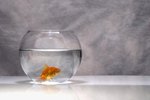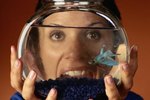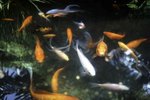
Goldfish reproduction is a bit of a mystery for novice aquarists, but most goldfish ordinarily won't propagate in captivity. For goldfish to mate and hatch fry in confinement, numerous conditions must be met. This can be a deterrent to some aquarists, but others state the animated antics and striking diversity make owning goldfish a fulfilling hobby. Naturally, the goldfish does reproduce in the wild and is normally a prolific propagator.
Reproductive Cycle
Goldfish reach their sexual maturity between their first or second year, but it isn't until age 6 or 7 before they start to reproduce. In the wild, female goldfish lay their eggs around proffered fixed objects, substrate vegetation or immersed tree roots. Goldfish eggs have a mucilaginous coating, ensuring the eggs remain where she scatters them. Being a "batch spawner," goldfish reproduction takes place in the spring and summer. Laying her eggs at this time of year usually ensures sustainable temperatures of 60.8 F, or warmer. Goldfish roe take three to seven days to hatch into fry, but the larval development term depends on the temperature.
Descriptive Details
The goldfish is an animated, mid-sized cyprinid who typically grows to about 8 inches. In the gene pool of nonindigenous cyprinids, the goldfish is most closely related to the common crucian carp. The lateral line runs from the fork of the tail to the gill slit. A typical goldfish is covered with 26 to 33 scales. With no barbels, the goldfish's mouth is terminus, surrounded with opaque lips and partly askance. The dorsal fin extends over the majority of the back, and the anal fin sits arrears, at the bottom of the belly. The caudal fin of the goldfish is underside, frontal and has no distinct margins. Pharyngeal teeth are set in one row of the goldfish's mouth and appear molar-like; specifically designed for gnashing. Wild goldfish are usually olive-green, silver and gray.
Ecosystem and Natural Resources
The natural habitat for goldfish is comprised of circulated backwater and stream-fed pools, with a substrate of lush aquatic vegetation. The hardy goldfish can tolerant murky water, temperature variations and water with minimal levels of dissolved oxygen. The ideal pH levels for goldfish is between 5.5 and 7.0. Research indicates that while goldfish can tolerate moderate levels of salinity, their eggs and fry languish in salty water. Case study indicates that the goldfish is more tolerant of aquatic pollution than many native fish species. The goldfish is omnivorous, and their diet is primarily comprised of crustacean plankton, insect larvae, fish roe, detritus and vegetation.
American Introduction
Called jin yu' in its native China, the goldfish is indigenous to Eastern and Central Asia, including China, Korea and Russia. Among the scientific community, it is believed the goldfish is the first exotic fish species imported to the United States. The first recorded release date in the U.S. occurred during the late 1600s, and the goldfish has since been located in every North American region and Hawaii. The bright colors of commercial goldfish are a result of selective breeding and a hybrid distinction.
References
- U.S. Department of the Interior-U.S. Geological Survey: Goldfish
- America Now: Pet fish creating a big problem in natural habitats
- Department of Natural Resources Ohio: Goldfish
- Goldfish - An Owners Guide to a Happy and Healthy Pet; Gregory Skomal PhD. Apr/1996
- Nations Online: Goldfish, Koi Fish in Feng Shui and Chinese Belief
Photo Credits
-
Hemera Technologies/AbleStock.com/Getty Images




